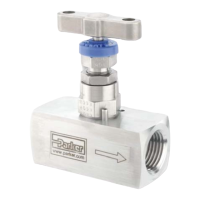Publication PSS-UM001A-EN-P – December 2016
What is the H Series Fieldbus DeviceNet Adapter? 2-7
The adapter is capable of holding approximately 64K of confi guration
data for H Series Fieldbus I/O modules connected to it. The adapter
sends confi guration data to an I/O module each time connections
are created with that module (i.e., power cycle or module insertion
to backplane).
You can exchange an old module for a new one if the following
conditions are met:
• ADR is enabled in the adapter.
• The new module matches the old one (i.e., electronic keying).
• The new module is inserted in the proper location (only for
modules using the backplane).
If the conditions listed above are met, the new module’s MACID is
changed to the appropriate value, if necessary, and the confi guration
information is subsequently downloaded to the module.
Physical Ordering
When power is applied, or when an I/O module is inserted, the
adapter detects the backplane I/O modules’ order, based on MACID.
With Physical Ordering, the adapter detects if any H Series Fieldbus
I/O modules connected to it are out of order. If this condition is
detected, the adapter changes the MACIDs of any new modules.
IMPORTANT
If any backplane I/O modules are missing when power is
applied, none of the backplane modules enter run mode.
The adapter’s MACID is always 0 on Subnet. The MACIDs of each
attached backplane I/O module must be sequentially ordered (i.e.,
each module’s MACID is greater than the left adjacent module).
Interscan Delay (ISD)
Interscan Delay is the time delay between consecutive I/O scans of
polled devices. The default setting is 10ms. The ISD=4ms for Auto
Start Mode. You can change this parameter in the Module window
of the scanner in the RSNetWorx for DeviceNet software.
The scanner uses this period of time to perform non-time-critical
communications on the DeviceNet network, such as communicating
with RSNetWorx for DeviceNet software. Setting this parameter to
a very low value increases the latency for non-time-critical scanner
operations, including the time required to respond to RSLinx software
and confi guration functions. Setting this parameter to a very large
value reduces the freshness of the I/O data being collected by the
scanner and is not advisable.
Foreground to Background Poll Ratio
Foreground to Background Poll Ratio is the ratio of foreground to
background polls. You can set this parameter in the Module window
of the scanner in RSNetWorx for DeviceNet software.
Devices can be polled on every I/O scan (foreground), or they can
be polled less frequently (background). Whether a particular device
will be polled in the foreground or in the background is determined
by its Poll Rate parameter on the Edit I/O Parameters dialog box,
which is accessed from the Scanlist property page.
The poll ratio sets the frequency of poll I/O messages to a device in
relation to the number of I/O scans. For example, if the poll ratio is
set to 5, the scanner will poll the selected devices once every six I/O
scans. We recommend that you use a poll ratio of 1.
Expected Packet Rate
Expected Packet Rate is the rate at which the packets will be
expected to be received by the scanner. You set this parameter in
the Module window (from the Advanced button) of the scanner in
RSNetWorx for DeviceNet software.
IMPORTANT
We recommend that you do not change the Expected
Packet Rate unless you are instructed to do so by a Rockwell
Automation technical support representative.
Transmit Retries
Transmit Retries are the maximum number of times that the scanner
will attempt to send an I/O message to a device before it times out
and generates an error message. You set this parameter in the
Module window (from the Advanced button) of the scanner in
RSNetWorx for DeviceNet software.
IMPORTANT
We recommend that you do not change the Transmit Retries
unless you are instructed to do so by a Rockwell Automation
technical support representative.

